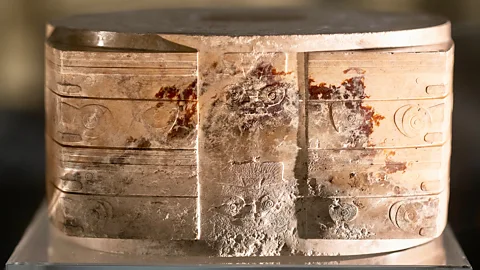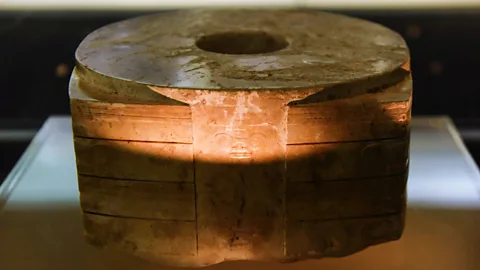The mysterious ancient figure challenging China’s history

 Chris Vile / Mustang Films
Chris Vile / Mustang FilmsA spectacular jade carving may hold the clue to an early society that predates what many historians believed to be China’s oldest, writes Alastair Sooke.
A grimacing figure wearing an elaborate feathered headdress is riding on the back of a frightening monster. He must be powerful, perhaps even supernatural, because he effortlessly subdues this sharp-clawed beast with bulging eyes. But who, exactly, is he? A shaman? A god? And why is he forcing historians to tear up the conventionally accepted timeline of Chinese history?
More like this:
Earlier this year, while filming China’s Greatest Treasures, a new six-part television documentary series for BBC World News, I encountered this mysterious character incised on a spectacular ancient jade carving that now belongs to the Zhejiang Provincial Museum in the city of Hangzhou. Known as a ‘cong’ (pronounced ‘ts-ong’) – essentially, a jade cylinder, squared on the outside, with a circular tube within – this squat column was recovered by archaeologists from a cemetery for elite members of a complex late Neolithic society that flourished at the site of Liangzhu, around 100 miles (160km) southwest of Shanghai, in the 3rd millennium BC. Traditionally, historians have taught that China’s earliest recorded dynasty was the Shang, who ruled during the Bronze Age, in the 2nd millennium BC.
 Getty
GettyIntricate bronze artefacts – ritual food and wine vessels; ceremonial axes embellished with bloodcurdling, grinning faces – have been excavated from Shang cities in modern-day Henan province, along the Yellow River. Many are decorated with the mask-like face of a monster with bulging eyes and curling horns known as a ‘taotie’, the precise meaning of which is still debated. Recent discoveries at Liangzhu, however, which is situated in the lower Yangtze River Basin, more than 600 miles (965km) southeast of the last Shang capital of Anyang, have upended the standard chronology of Chinese history. This is because, according to archaeologists, the impressive ancient settlement at Liangzhu was home to a sophisticated civilisation that was already prospering 1,700 years before the establishment of the Shang. Contemporaneous with the ancient Cycladic civilisation of the Aegean Sea in the West, it was possibly the earliest state society in East Asia.
Some scholars even suggest that the origins of the famous Shang ‘taotie’ motif may be the gargoyle-like, frog-eyed monster that decorates artefacts from Liangzhu, including the ‘cong’ – which is known as the ‘king of cong’, because of its impressive heft of 6.5kg (14.33lbs) – that I saw at Zhejiang Provincial Museum.
Earlier this year, the archaeological ruins at Liangzhu were designated a Unesco World Heritage site. Today, visitors can marvel at extraordinary artefacts from the city at the beautiful Liangzhu Museum, designed by British architect David Chipperfield. On display are many more jade grave goods, including ceremonial axe-heads, ornamental combs, and circular discs with a central hole, which look like oversized Polo mints and are known as ‘bi’. Located at the foot of Mount Tianmu, the principal settlement of Liangzhu was a fortified town encompassing a rectangular area of approximately 740 acres (299 hectares), protected by a system of moats and rammed-earth walls at least 65ft (19.8m) wide. Visitors could enter via one of eight water gates – suggesting that, in the words of archaeologists Colin Renfrew and Bin Liu, “this was a town of canals as much as of roads”.
A civic emblem?
The sophistication of the civilisation that flourished at Liangzhu from approximately 3300-2300 BC is evident not only in the precious finds from the town’s high-status cemetery, but also from a remarkable network of monumental earthen dams, amounting to an extensive system of hydraulic works, and carefully managed rice paddy fields, arranged across the surrounding area. These ensured a regular supply of food for the city’s inhabitants. Within the settlement, archaeologists discovered a massive pit of charred rice – “perhaps burnt in a granary located in the palace nearby and subsequently discarded,” say Renfrew and Liu.
 Getty
GettyClearly, then, thanks to their social organisation and mastery of irrigation techniques, the Liangzhu people had a hefty surplus of food – and this bought them an important stimulant to civilisation: the luxury of time. Freed from the daily, hand-to-mouth struggle for survival, the Liangzhu elite became besotted with art. Just look at their obsession with jade, an obstinate, almost impossibly tough mineral, which their craftsmen painstakingly worked into spectacularly fine grave goods.
In the past, Chinese scholars believed that the earliest dynasty to value jade was the long-lasting Zhou, which followed the Shang in the 1st millennium BC. The evidence from Liangzhu, though, suggests otherwise. And the ‘king of cong’ that I saw – carved from a pure, creamy-coloured type of jade called nephrite – is arguably the most spectacular of all the Liangzhu jades. What struck me was how sleek and crisp and gracefully minimal it was – if you weren’t familiar with it and were told that it had been carved by, say, the 20th Century modern sculptor Constantin Brancusi, you wouldn’t bat an eyelid.
 y: Getty
y: GettyAnd the precise significance of that ‘man/beast motif’, as some art historians describe it? Well, in the absence of written records from the site of Liangzhu, scholars can only speculate. For now, we can’t be sure if the figure is a deity or a member of the Liangzhu elite – some of whom wore feathered headdresses – such as a shaman or priest. Or maybe, as Renfrew and Liu propose, the motif could be interpreted “in social terms, as representing the corporate community of Liangzhu town”. In other words, perhaps the solution to the riddle of this puzzling design is that it is a kind of civic emblem, akin to a Western coat of arms.
China’s Greatest Treasures is on BBC World News on Sat 12 Oct at 03:30 and 16:30 and on Sun 13 Oct at 01:30; 10:30 and 22:30 GMT.
Alastair Sooke is The Telegraph’s Chief Art Critic.
And if you liked this story, sign up for the weekly bbc.com features newsletter, called The Essential List. A handpicked selection of stories from BBC Future, Culture, Worklife and Travel, delivered to your inbox every Friday.
